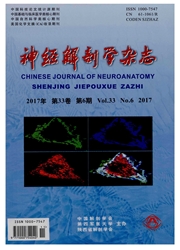

 中文摘要:
中文摘要:
神经脱髓鞘疾病是中枢神经系统难治性疾病,髓鞘脱失后伴有各种基因表达的异常。明确这些基因的表达形式对脱髓鞘疾病的治疗具有重要意义。本研究利用0.2%cuprizone饲育C57BIM6小鼠6周制备中枢神经脱髓鞘模型,采用原位杂交技术对组织蛋白酶抑制剂cystatin F的mRNA表达进行研究。结果发现,正常野生型小鼠中枢神经系统中未见cystatin F mRNA的表达,而大量表达于脱髓鞘模型小鼠白质内。通过小胶质细胞标志物Ibal抗体免疫组化和c-fms的原位杂交研究发现,脱髓鞘模型小鼠白质内有大量激活的小胶质细胞。为进一步确定表达cystatin F的细胞类型,通过cystatin F原位杂交后IbM免疫双染技术,确定cystatin F在中枢神经主要由激活的小胶质细胞表达,提示其表达与小胶质细胞活化和崩解髓鞘残骸清除有关。
 英文摘要:
英文摘要:
Demyelination disease is a refractoriness neurological disease in the central nervous system (CNS). Accompanying demyelination, numerous genes expression has been found changed. Investigation into the expression pattern of these genes is important for the treatment of demyelination disease. In this study, 0.2% cuprizone diet C57BL/6 mice were used to establish acutely demyelinated model. Using these model mice, the expression of cystatin F, which is an inhibitor of cathepsin protease, was analyzed by in situ hybridization method. The results showed that no expression of cystatin F could be detected in the CNS in wild type mice ; however, significant cystatin F expression was observed in white matter in model mice. Futhermore, considerable activated microglia was found by using Ibal antibody and c-fms probe as the marker of activated microglia. In order to clarify which type of cells expressed cystatin F, Ibal immunostaining and cystatin F in situ hybridization were carried out. The results showed that cystatin F was expressed by activated microglia. These results indicate that the expression of cystatin F is correlated with the activation of micrglia and cleaning of myelin debris.
 同期刊论文项目
同期刊论文项目
 同项目期刊论文
同项目期刊论文
 期刊信息
期刊信息
